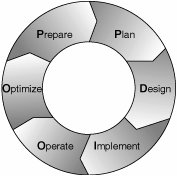Solutions Lifecycle
| The lifecycle of your WLAN project can be broken down into discrete yet related phases. This is known as your solutions lifecycle. The phases are preparing, planning, designing the architecture, implementing the solution, operating the infrastructure, and finally optimizing the system (PPDIOO). Note that this is not a linear but rather a circular process. Lessons learned and best practices are essential for a better, faster, and more cost-effective design. They can be used to continuously develop and perfect the final solution. Figure 3-1 illustrates the PPDIOO lifecycle. Figure 3-1. PPDIOO Solutions Lifecycle Ultimately, the goal of technology investments is to maximize the business's benefit while simultaneously minimizing both the technology's and project's risk. A sound business case and positive Net Present Value (NPV) for your WLAN project alone are not sufficient to ensure that you accrue the full benefits from your WLAN. Indeed, identifying, qualifying, and quantifying the business drivers are only the first steps in turning your vision into reality. Proper preparation, planning, and execution are vital to getting the solution deployed. Typically, preparation includes such aspects as identifying the business case and requirements, defining the enterprise's wireless strategy, working on return on investment (ROI). Preparing your WLAN deployment also means examining the current enterprise business and network infrastructure, defining a funding model, and then deciding the breadth and scope of your deployment. Planning is the "opening" step in the project proper, where you create your project teams and have your first planning kickoff meeting. You also identify your key resources and detail your high-level project plan or schedule. Of course, each enterprise and each deployment is unique, and the solutions lifecycle should be considered simply as a tool to help tailor and manage the WLAN project to your needs. This chapter takes you through the most common steps in the preparation and planning stages. There is simply no single "best approach." There are no standard, canned answers or solutions to the questions that are covered in this chapter. However, by providing a structured methodology for tackling the challenges at hand, the solutions that are specific and relevant to your organization will more readily present themselves. |
EAN: 2147483647
Pages: 163
